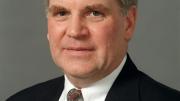Thomas E. Vautin, the University's associate vice president for facilities and environmental services, will become acting vice president for administration on July 1, President Drew Faust announced today.
Vautin assumes the post that Sally H. Zeckhauser has held since 1988, but is vacating with her June 30 retirement. He had previously been named as one of the people accepting an early-retirement incentive; the news release says he now plans to retire "during the next academic year."
Faust said she was "delighted" to announce Vautin's appointment, calling him "a dedicated member of the Harvard community for more than three decades."
Another top administrative post will become vacant on August 1, when executive vice president Ed Forst departs. Faust said Vautin would "provide important continuity in...key administrative functions" during the search for Forst's replacement.
The full text of the news release appears below.
Vautin to serve as acting vice president for administration
President Drew Faust announced today that Thomas E. Vautin will be Harvard's acting vice president for administration (VPA), effective July 1. Sally H. Zeckhauser, currently the vice president for administration, is retiring at the end of June.
With more than 31 years of experience at the University, Vautin will take interim responsibility for coordination of Harvard's major service units, including University Operations Services, Harvard Real Estate Services, and Harvard University Dining Services, pending his own retirement during the next academic year.
"I am very grateful that Tom has agreed to take on these duties," said Faust. "Tom has served Harvard over many years with exceptional effectiveness and dedication, and he will provide important continuity in these key administrative functions as we carry out the search for the next executive vice president."
"My primary objective will be to support the University during the transition of leadership within her senior administration," Vautin said. "In addition, I will be working to address several key positions and functions in these departments that will be affected by the voluntary early retirement program. My personal goal will be to ensure that the VPA organization is fully engaged and ready to work with the new leadership."
Vautin has served as associate vice president for facilities and environmental services for Harvard University since the mid-1990s and in that role he has overseen the University Operations Services group. Additionally, Vautin's responsibilities have included co-founding the Harvard Green Campus Initiative. As chair of the University's Incident Support Team, he played an instrumental role in Harvard's response to the emergence of H1N1 influenza.









